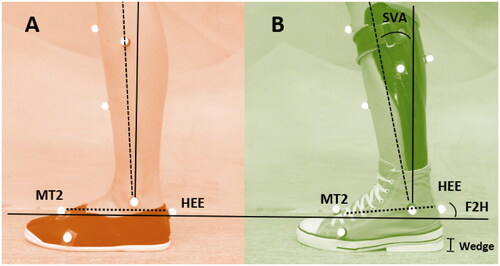Figures & data
Figure 1. Lower leg/foot markers for (A) NS-SHOES (non-supportive textile shoes) and (B) AFO-footwear combination. Heel height was incremented by placing wedges of 5, 10, and 15 mm below the heel surface of the shoe (indicated with I, (B)). Shank to vertical angle (SVA) was calculated as the orientation of the shank (knee joint centre to ankle joint centre), to the vertical in the sagittal plane. Foot to horizontal angle (F2H) was calculated as the position of the foot (MT2-HEE) to the horizontal in the sagittal plane. Note that markers remained attached to the shoe and AFO for all AFO walking trials.

Figure 2. Time-normalised gait curves (left panel) and accompanying values at specific gait events (right panel) for a 9 y old girl walking with knee hyperextension (EXT), for sagittal hip and knee angles, internal knee moment, shank to vertical angle (SVA), and foot to horizontal angle (F2H). NS-SHOES: non-supportive flexible shoes (red/dashed), AFO: ankle foot orthosis (green), with incremented heel height of 5, 10, and 15 mm. Vertical dash-dotted lines (left) represent timing of gait events (initial contact (IC), peak knee flexion (PKF), midstance (MST), and maximal knee extension at terminal stance (TST)). Horizontal dash-dotted lines (right) represent mean ± 1SD of typically developing children. Positive foot to horizontal angles indicate an upwards positioned forefoot, with respect to the floor surface. Recl: reclined; incl: inclined.

Figure 3. Effect of ankle foot orthoses with incremented heel height (AFO, +5, +10, and +15 mm) on sagittal hip, knee, shank to vertical (SVA), and foot to horizontal (F2H) angles. Group results (mean-SD) are presented for children walking with excessive knee flexion gait pattern (FLEX) and knee hyperextension (EXT). NS-SHOES: non-supportive flexible shoes; AFO: ankle foot orthosis; incl: inclined; recl: reclined; up: forefoot up with respect to floor; down: forefoot down with respect to floor (i.e., representing heel rise). Note that no significant interaction effect was found between group and heel height.

Table 1. Characteristics of the participants and their ankle foot orthoses (AFOs).
Table 2. Group results (mean ± SD) of children walking with excessive knee flexion (FLEX) and knee hyperextension (EXT).
Figure 4. Individual shank to vertical angle (SVA) at midstance scattered against sagittal knee angles (upper row), sagittal internal knee moment (second row) and SVA (third row) at initial contact, midstance (MST) and terminal stance for different walking conditions. Mean data of each condition are presented for all individuals. Regression lines (dotted) are presented when generalised estimation equations (GEE) analysis indicated a significant relation (p < 0.05). Grey squares represent reference data of typically developing children (±1SD) [Citation28]. NS-SHOES: non-supportive flexible shoes; AFO: ankle foot orthosis, incremented with 5, 10, and 15 mm wedge below the heel surface. GPS: gait profile score.
![Figure 4. Individual shank to vertical angle (SVA) at midstance scattered against sagittal knee angles (upper row), sagittal internal knee moment (second row) and SVA (third row) at initial contact, midstance (MST) and terminal stance for different walking conditions. Mean data of each condition are presented for all individuals. Regression lines (dotted) are presented when generalised estimation equations (GEE) analysis indicated a significant relation (p < 0.05). Grey squares represent reference data of typically developing children (±1SD) [Citation28]. NS-SHOES: non-supportive flexible shoes; AFO: ankle foot orthosis, incremented with 5, 10, and 15 mm wedge below the heel surface. GPS: gait profile score.](/cms/asset/73cb12a1-fbdc-412f-a203-baa6aa622acf/idre_a_1970829_f0004_c.jpg)
